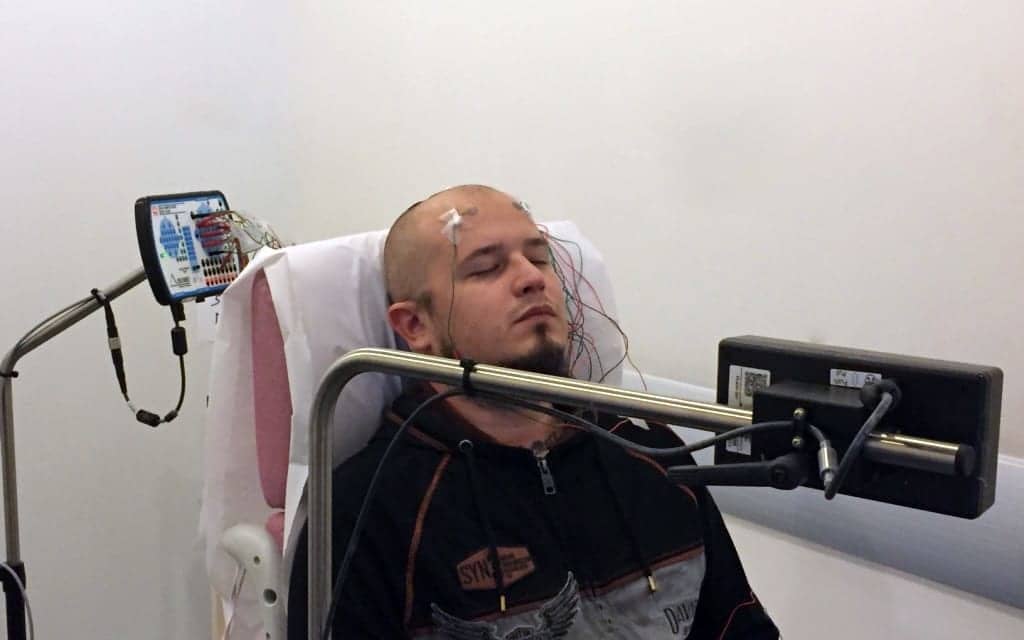In 2015 Francesco Greco, head of the Laboratory of Applied Materials for Printed and Soft electronics (LAMPSe) at the Institute of Solid State Physics at Graz University of Technology, developed so-called “tattoo electrodes” together with Italian scientists. These are conductive polymers that are printed using an inkjet printer on standard tattoo paper and then stuck to the skin like transfers to measure heart or muscle activity.
This type of electrode opened up completely new paths in electrophysiological examinations, such as electrocardiography (ECG) or electromyography (EMG). Thanks to a thickness of 700 to 800 nm—about 100 times thinner than a human hair—the tattoos adapt to uneven skin and are hardly noticeable on the body. Moreover, the “tattoos” are dry electrodes; in contrast to gel electrodes, they work without a liquid interface and cannot dry out. Even hairs growing through the tattoo do not interfere with the signal recording.
New Generation of Tattoo Electrodes
Building on this achievement, Greco, together with Esma Ismailova (Department of Bioelectronics, École Nationale Supérieure des Mines de Saint-Étienne, France) and Laura Ferrari (The BioRobotics Institute, Scuola Superiore Sant’Anna, Italy), has now achieved a further milestone in the measurement of bioelectrical signals: the group has modified the tattoo electrodes in such a way that they can also be used in electroencephalography (EEG), that is, to measure brain activity.
To do this, the researchers used the same approach as in 2018, that is, inkjet printing of conductive polymer on tattoo paper. The composition and thickness of the transfer paper and conductive polymer have been optimized to achieve an even better connection between the tattoo electrode and the skin and to record the EEG signals with maximum quality, because “Brain waves are in the low frequency range and EEG signals have a very low amplitude. They are much more difficult to capture in high quality than EMG or ECG signals,” says Laura Ferrari, who worked on this project during her PhD and is now a postdoc researcher in France, in a release.
Tests under real clinical conditions have shown that the EEG measurement with the optimized tattoos is as successful as with conventional EEG electrodes. “Due to inkjet printing and the commercially available substrates, however, our tattoos are significantly less expensive than current EEG electrodes and also offer more advantages in terms of wearing comfort and long-term measurements in direct comparison,” says Greco.
MEG-compatible Dry Electrodes
The new tattoo electrodes are the very first dry electrode type that is suitable for long-term EEG measurements and at the same time compatible with magneto-encephalography (MEG). MEG is a well-established method for monitoring brain activity, for which so far only so-called “wet electrodes” can be used. Such electrodes work on the basis of electrolyte, gel, or an electrode paste, and so dry out quickly and are unsuitable for long-term measurements. The new generation of tattoo electrodes consists exclusively of conductive polymers, which mean it does not contain any metals which can be problematic for MEG examinations, and is printed exclusively with inkjet. “With our method, we produce the perfect MEG-compatible electrode while reducing costs and production time,” says Greco. The TU Graz researcher is currently spinning ideas on how this technology can be used in clinics and in neuroengineering as well as in the field of brain computer interfaces.
A paper on the electrodes is published in journal Flexible Electronics.




